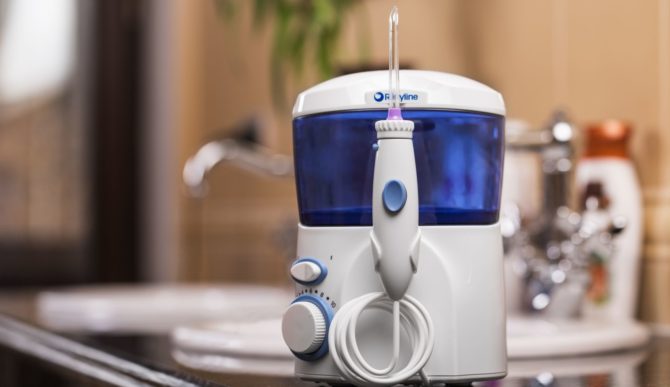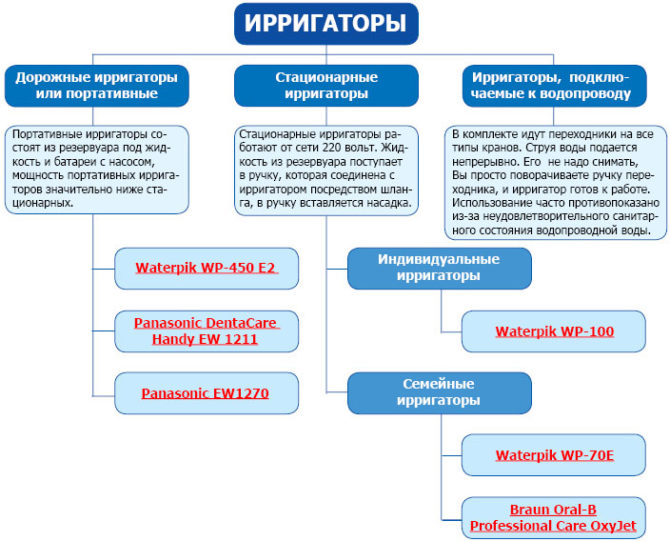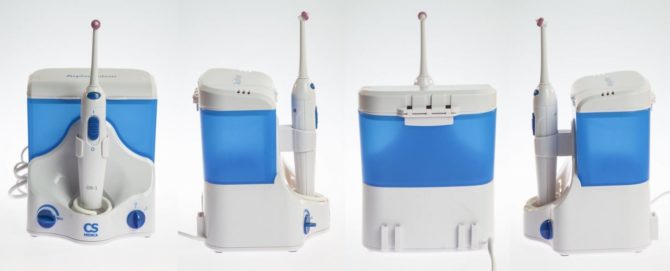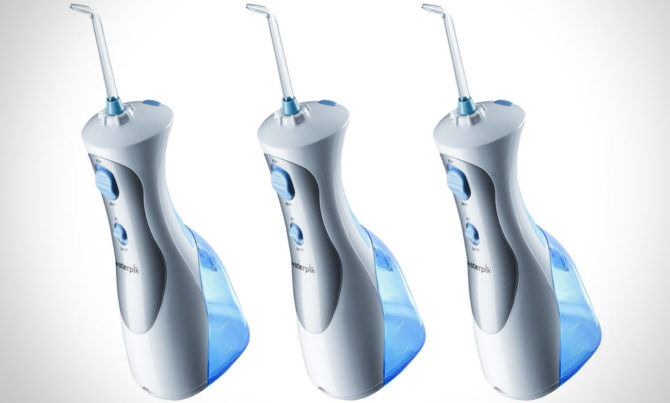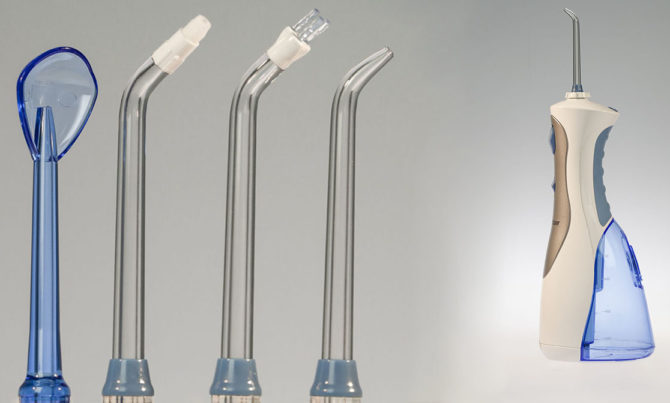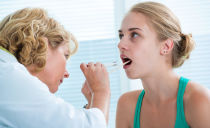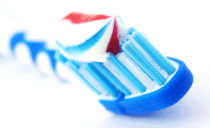What is an irrigator for teeth and why is it needed
Irrigator is an apparatus for high-quality cleaning of the oral cavity. The principle of operation of the device is to supply water under pressure, which cleans even the most inaccessible spaces between the teeth, areas under fixed dentures.
Content
Why and for what an irrigator is needed and what it is
The irrigator is used for better hygiene procedures in the mouth, it allows you to clean the dental surface from plaque and stone almost at a professional level. This apparatus differs from other hygienic devices: ordinary and electric brushes, flosses.
The oral irrigator is designed to clean teeth from fresh and old plaque. A thin stream of water gently eliminates food debris, deposits from gingival pockets, cleans interdental spaces without injuring or irritating the gums. Traditional hygienic devices (toothbrushes, flosses) are unable to clean such remote areas. One more The advantage of the device is that it provides an impact in which the risk of damage to the mucous membranes of the oral cavity is reduced to zero.
Constructive
A dental irrigator consists of a mechanical part (hydraulic pump) and a water tank. Under the pressure of the hydraulic pump, the liquid from the reservoir enters the handle, and from it into the nozzle and into the oral cavity. Depending on the task of the hygienic procedure, you can adjust the pressure of the water jet, which allows you to achieve the highest possible cleanliness of the teeth. On the market are devices with a pulsating, constant, atomized water jet.
Scope of application
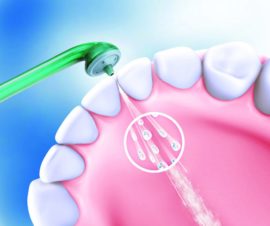 An irrigator is needed to maintain a clean oral cavity, sparing tooth cleansing in diseases of the gums and periodontium. The main task of the apparatus is to remove food debris from the interdental areas. The device effectively cleans the most inaccessible places: under orthodontic structures, prostheses. Also, an irrigator is needed for high-quality cleansing of crowded teeth.
An irrigator is needed to maintain a clean oral cavity, sparing tooth cleansing in diseases of the gums and periodontium. The main task of the apparatus is to remove food debris from the interdental areas. The device effectively cleans the most inaccessible places: under orthodontic structures, prostheses. Also, an irrigator is needed for high-quality cleansing of crowded teeth.
By cleaning the mouth, water simultaneously massages the gums. Adjusting the pressure of the fluid supply allows you to make cleaning your teeth gentle or intense. Massage effect allows you to accelerate blood circulation in the gums and mucous membranes, get rid of stagnation in the tissues, often provoking inflammatory processes.
In addition to ordinary water, the irrigator can spray any liquid, including special agents with disinfecting, hemostatic, anti-inflammatory, fluorinating characteristics.
A wide range of nozzles allows you to keep clean not only the oral cavity, but also the nasopharynx. It contributes to:
- Cleansing and moisturizing the nasal cavity.
- Facilitation of the course of ENT diseases: rhinitis, sinusitis, sinusitis.
The use of the device during acute inflammatory processes in the oral cavity is not recommended. The device is contraindicated for preschoolers who cannot use it themselves due to the solid size and weight of the irrigator. However, some manufacturers produce devices intended for young users.
Types of irrigators - which is better to choose
Oral irrigators are effective regardless of the type of model.But different devices have unique functional characteristics, which allows you to choose the best device depending on the purpose of its acquisition.
Regulation of water pressure allows the use of an irrigator for various diseases of the oral cavity. The pressure of a low-intensity jet is suitable for people with weak enamel and sensitive gums. High-intensity pressure will help to clean teeth from “smoker” plaque, and remove old deposits.
The possibility of using additional fluids will improve the oral cavity, strengthen teeth, and restore the natural color of enamel. Regulation of the intensity of the water supply allows for an effective hydromassage procedure.
In addition to technical characteristics, devices differ in the principle of operation. There are stationary devices that operate from the network and are connected to the water supply, as well as portable irrigators that operate from the network or battery.
Stationary appliances
A stationary irrigator for teeth is a device that works from the network or is connected to the water supply. This type of device is best to choose for home use. It features a wide range of functionality and a variety of modes.
The volumetric tank for water will allow less often to add liquid to the tank. Stationary irrigators are able to create the highest possible pressure when applying a jet; they are equipped with additional nozzles for carrying out preventive procedures, cleaning orthodontic structures (braces) and teeth whitening.
Portable devices
This type of irrigator is convenient to use when traveling and traveling. Such models are compact in size, work on batteries or battery.
Unlike stationary models, portable irrigators are not able to create high pressure when water enters. Due to the small volume of the reservoir, the liquid is only enough for 1 procedure, so for using the whole family it is better to choose a stationary device.
Nozzles
One or more hardware accessories may be included with the device. Some of them are suitable for daily hygiene, others are used to affect certain areas of the oral cavity and for various diseases. Types of nozzles:
- Standard. The nozzle is used for conventional irrigation procedures: cleaning teeth and gums from food residues, plaque, hydromassage.
- To clean the surface of the tongue. The design eliminates plaque from the tongue, the inner surfaces of the cheeks, and the sky. Used after brushing your teeth, prevents the appearance of halitosis.
- Brush. The nozzle works on the principle of an automatic toothbrush.
- Periodontic. It has a special soft tip that allows you to direct the stream to the edge of the gum and into the gingival pocket. It can be used to clean areas under bridge structures and dentures.
- Orthodontic. The design combines the functions of a toothbrush and irrigation. A gentle brushing with a soft bristle ends with irrigation and rinsing with water. The nozzle is used to ensure the cleanliness of crowded teeth, bracket systems.
- Cleaning nozzles are needed to ensure cleanliness in hard-to-reach places (under crowns, implants, bridges). They allow you to get rid of the most stable plaque.
- Nasal. It is used for the prevention and treatment of rhinitis, sinusitis, the initial stage of sinusitis. Helps reduce inflammation in the nasal cavity, moisturize the nasal mucosa, which reduces the duration of the course of the disease.
Nozzles must be regularly cleaned, washed and kept in a special container to prevent the accumulation of pathogenic bacteria and microbes.
Fluid for apparatus
Strengthen the effect of cleaning the oral cavity by adding special fluids to the irrigator. Independently, without consulting a dentist, you can choose hygienic fluids.They can be used daily. These rinses help to improve the quality of oral hygiene: they cleanse teeth, take part in the fight against deposits and plaque, and freshen breath.
Plaque creates a favorable environment for the growth of bacteria and the development of infection. Hygienic solutions can prevent the occurrence of infectious and inflammatory processes in the oral cavity.
Directional conditioners are prescribed by the dentist. These fluids are used as an additional tool to combat dental diseases: gingivitis, periodontal disease, stomatitis. Such remedies include therapeutic solutions to eliminate bleeding gums, anti-inflammatory balms, herbal decoctions, rinses containing fluorine, calcium, potassium and other trace elements that strengthen tooth enamel.
It is not recommended to rinse the oral cavity after using therapeutic solutions, since their therapeutic effect can be reduced.
Special attention should be paid to fluids that help get rid of stable dental deposits. Such funds are actively involved in the process of stone destruction on enamel, the improvement of the oral cavity is observed after several procedures. It is not recommended to direct a stream with this liquid on the gums - solid particles contained in the solution can damage soft tissues. It is necessary to avoid getting the solution into the larynx - the composition of the liquid will cause discomfort, it will irritate the sensitive mucosa.
Terms of use of the irrigator
Dentists recommend using an irrigator for teeth in combination with a regular toothbrush. A quality brush does not reach hard-to-reach areas, but provides cleaning of open areas.
For the device to work smoothly, you must adhere to the basic rules for its operation:
- It is not recommended to turn on the device with an empty container, this can lead to overheating and damage to the device.
- Filter herbal decoctions before use to avoid clogging the irrigator.
- After applying medical and hygienic solutions, it is necessary to thoroughly rinse the parts of the device.
The maximum effect of hygiene, medical and preventive procedures is achieved by observing the following rules:
- It is not recommended to direct the stream from the edge of the tooth to the gum, so as not to increase the pressure on the posterior pocket. The stream must be directed from the gum to the lower border of the tooth.
- Do not use too high a water head. It can have a traumatic effect, especially in the presence of diseases of the oral mucosa. Interdental spaces should be treated with weak or medium water pressure.
- The hygienic procedure must be carried out by tilting the body forward. This situation will prevent water from entering the throat. You need to lean back while using nasal nozzles to achieve the greatest effectiveness when washing your sinuses.
A compact and convenient device helps to keep the oral cavity clean every day, making the cleaning process not only effective, but also pleasant. Follow the simple rules of use, and the irrigator will become an indispensable tool in maintaining oral hygiene, treatment and prevention of many dental diseases.

